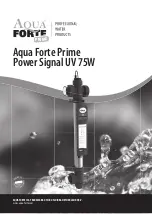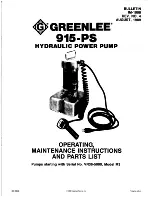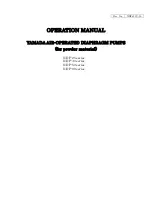
Laguna Aeration Kit
Installation:
Note:
The pump should be placed in a location, which is dry and relatively free from dust. Do not place the
air pump on carpet since fibers may collect on the pump and restrict air entering the pump. This will reduce
air output and the service life of the pump.
The air pump should be installed by following either of the recommended methods:
Method 1
Place the air pump on a surface lower than the water level of the pond. Important: It is recommended to
always use a check valve (sold separately item #411221) in the air line between the air pump and pond. The
check valve will help prevent water from siphoning out of the pond through the air hose and into the pump in
the event of a power failure or when removing filters and other air-driven accessories from the pond.
Method 2
Place the air pump on a surface higher than the water level. The surface should be at least 12 inches higher
than the water level of the pond, but not placed directly above the pond. The surface should have a raised
edge to prevent the air pump from sliding off. Use a check valve in the air line between the air pump and the
pond to prevent back-siphoning.
Once the air pump has been installed:
1. Attach one end of the air line tubing to the air outlet on the air pump.
2. Run the air line tubing through the Styrofoam float and then attach the air stone to the end of the
tubing.
3. Put the air stone in the in the pond and adjust the length of the tubing so that the air stone floats at
a depth of 2 feet or at half of the depth of the pond. Make sure that the tubing has no kinks or
restrictions.
4. Plug the air pump into the electrical outlet or wall receptacle. Be sure to allow for a drip loop.
Caution:
Care must be taken during installation to ensure that water cannot siphon out of the pond through
the air hose and damage the air pump.
Air Flow Adjustment
The OPTIMA air pump incorporates a rheostat to control air output. Turning the knob clockwise increases
the air flow and counterclockwise reduces the air flow. Proper use of the rheostat reduces harmful back
pressure and lengthens the service life of the pump.
In order to achieve correct air flow, a balance between the valve setting and the pump output is necessary.
The ideal setting is obtained by minimum backpressure or unrestricted air flow. Never physically restrict the
output of the air pump. Restriction causes damage to the diaphragm. Adjust air valve output required.
Back Pressure
Back pressure is the buildup of pressure on the diaphragm due to restricted air flow. This occurs when
excess air is produced by the air pump or when the air channels are inadvertently blocked. Over time,
backpressure resulting from clogged air diffuser or other air system blockages and restrictions will cause the
diaphragm to expand or rupture. Note: An expanded diaphragm leads to a loss of air volume while a rupture
will result in the total loss of air.
Maintenance (External Appearance)
Remove dust and grime with a soft, damp cloth. Do not immerse pump in water.
.
Air Stone and Air Line
The pump requires no regular internal maintenance during its service life. The rest of the air system should
be periodically checked and cleaned











